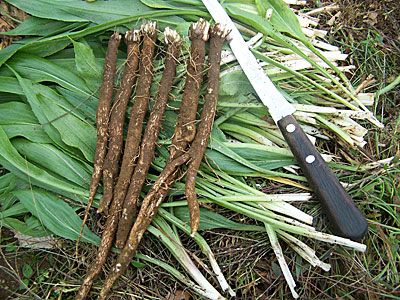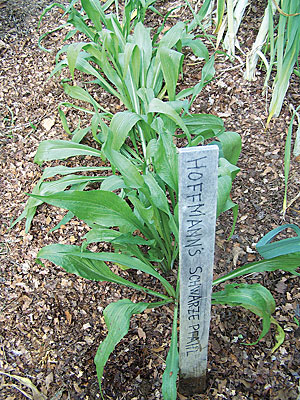Salsify Rest Api You Need to Sign in Before Continuing
 |
| 'Hoffmann's Schwarze Pfahl' black scorzonera, growing at Khadighar. Will Bonsall photo. |
As a youth, I knew salsify only as an obscure reference in an Uncle Remus tale, along with persimmons and calamus root. But never Salsify.
When I began gardening, I saw salsify in the novelty section of seed catalogs, along with plants such as comfrey and borage. Relegated to such a minor role, I assumed we were not expected to take them too seriously, which is why I paid special attention to them. After all, many other "neglected crops" had turned out to be especially useful for my subsistence-oriented homestead. Farmer market-goers didn't appreciate the slender, rough-skinned roots in the marketplace, but it didn't mean they had no place on my table.
What is Salsify
The fact that two plants are called salsify immediately complicates this subject. "True" salsify, aka oyster plant (Tragopogon porrifolius), has a white root and purple flowers. Meanwhile false, aka black or Spanish salsify (Scorzonera hispanica), has a black root and yellow flowers. While different species, both are composites (Asteraceae) and farmers both grow and use them in essentially the same way. Both are native to western Eurasia and people grow them primarily for their long, slender taproots.
Although they don't size up as well as, say, carrots, both salsifies have a unique flavor – sort of a mild mineral taste – that some find evocative of the seashore. The name "oyster plant" comes from a supposed resemblance to those boogery bottom feeders. Fortunately, I don't get the similarity at all. However, I have especially enjoyed adding grated salsify (of either type) to potato croquettes to create a sort of vegan seafood dish.
 |
| Will Bonsall photo. |
Their skinniness is exacerbated by the rough outer skin, which requires scrubbing and even scraping to remove any "dirty" taste. On the other hand, the interior has an "earthy" flavor. Some folks even feel the need to peel them, which doesn't leave much to eat. If only they were a lot fatter … hold that thought.
Growing Bigger Salsify Roots
As for their size problem, I may have a foil for that, at least in the case of Scorzonera. It has to do with the biennial, or rather pseudo-biennial nature of Scorzonera. The strictly biennial species, such as carrot, turnip and beet, spend their first year forming a fleshy taproot. In the second year, root puts ALL their energy into making flowers and seeds. In the process the root is exhausted, becoming cracked and woody and rotten and finally, dead.
Some crops, such as Scorzonera, seem to be able to sustain the sexual process while continuing vegetative growth. I removed some second-year plants, and I replanted the following spring. I made sure to space them about a foot apart to give them enough room to produce a seed crop. In this process, I noticed that the roots had grown much larger than when they were first replanted. But I noticed that they were still crisp and tender and very edible, indeed much nicer than the first year roots.
What does this imply for the gardener? That you can grow nice big salsify if you're willing to tie up garden space for a full two seasons? Is it worth it? The latter is a subjective question that you must answer for yourself. But I wonder if it is necessary to sacrifice two whole seasons. I suspect I might plant the seed late in the first season, and let it make whatever growth it will. It's disappointing for an annual perhaps, but sharing the first season with the primary crop. Then in the second season, the root might fatten up just or nearly as well. I say "might" because this is a fairly recent discovery for me and I'm still following up on it.
When to grow
Of course, farmers plant crops such as garlic and the winter grains in late summer or fall, but they use only the first half of the second year. On the other hand, I assume that Scorzonera requires the entire second season to size up. Would it make flowers and seeds after that scanty first-year beginning, or, like late-planted onions? Will it merely form "sets," which will size up better in the following year? I really don't care much, as I can grow my seed crop elsewhere. If the second-year roots do make a seed crop, fine.
Would the roots yield more if flower shoots were removed as they form? Or, if Scorzonera can produce flowers without sacrificing root yield, all the better. The young, unopened flower buds are quite edible. Much like dandelion buds (another composite), they are packed with nutrients and are excellent in stir-fries. Thus we could produce two crops at once.
Edible Foliage
The foliage of both types is also quite edible when young and can be added to stir-fries. However, by the time the roots are mature, all but the inner leaves have grown tough. So how can one harvest the foliage without sacrificing the (in my opinion) more important root crop? That brings me to a whole other use for salsify.
If you save your own salsify or Scorzonera seed, as you should, then it is sure to spread. It mainly happens through the work of goldfinches, which adore all composites seeds. Is that a problem? I fail to see how. In fact, I have found Scorzonera in particular to be a very useful plant for pasture improvement, so let me digress.
I'm always trying to upgrade my hayfield to make it more productive; It's vital to sustaining the fertility of my cropland by furnishing material for compost and mulch. Since I don't keep livestock, I'm not very picky about WHAT grows there, as long as there is a lot of it and it helps build soil. Most pasture plants – especially the grasses and clovers – have their primary activity in the top 6 to 8 inches of the soil. Here, microbes are most abundant and active. However, most of the minerals lie deep down, beyond the reach of most pasture plants. Species with strong, deep roots are vital "miners," extracting and pumping up soluble minerals from the otherwise inaccessible subsoil.
Root Network
Inside our gardens, we may spare Scorzonera much of an effort by using the broadfork to pre-loosen the subsoil. This helps the plants focus on fattening themselves up. In the hayfield, however, I count on them to do the hard work for me, along with yellow dock, dandelion, comfrey, chicory and other tap-rooted plants. In addition to collecting minerals for me, they eventually die and deca. This leaves a network of hollow, humus-filled tunnels to afford passage into the underworld for earthworms and all the other creatures that comprise a vibrant soil community. All those soil denizens, following in the wake of those trailblazing taproot plants such as Scorzonera, carry with them that civilization we call topsoil into the sterile wilderness of subsoil.
Now THERE, in the pasture, I see no harm in harvesting some salsify greens for stir-fries. Much like dandelions, plenty remain to continue the work of soil building. If those particular plants are set back a bit by the scalping, they have plenty of time to recover.
Planting and Continuing Salsify Care
However, back in the garden, here's how I grow salsify to eat. I sow them early, at least by mid-May, as there are quite cold hardy. In fact, I often interplant salsify with carrots or parsnips, as they are said to repel root maggots. Like parsnips, they require a long season to fatten up properly, so I let those salsifies overwinter in the ground alongside the parsnips, and harvest both in early spring, or, with protection, throughout the winter. You can dig up salsifies, with carrots interplanted with them, and eat them throughout the autumn and winter.
Of course, I use a lot more carrots than salsify, so I space and thin salsify to no more than one per foot within the carrot row. Whether together or separate, I make sure the soil is rich in humus, high in minerals (a little wood ash doesn't hurt, especially since salsify is usually companioned with peas) and with only moderate nitrogen, as excess N could result in forked and misshapen roots that store poorly. Steady moisture is important at the beginning; once the taproot reaches down, it will be fairly drought resistant, but adequate water throughout the season will ensure fatter roots.
Both salsify and Scorzonera are subject to little or no improvement by breeding and selection. Indeed for a long time only one named variety of true salsify existed: 'Mammoth Sandwich Island', which is curious, as I know of no Hawaiian connection for it, and it is only mammoth compared to … well, I don't know what. A few other varieties have appeared over the years, especially in Europe, but I see little variation in them; indeed some are mere synonyms.
Disease and pests
Salsify is generally free of insect and disease problems, which is remarkable since it contains little of those bitter, pungent or resinous principles that so many other plants use to defend themselves. It does contain an abundance of the milky sap common to many composites (from which lettuce takes its name – in French, lait means "milk"), and this latex soon coagulates on broken surfaces, making your fingers sticky (just imagine if you were a bug…aargh!).
Salsify also contains a lot of levulin, the same complex carbohydrate found in terrasols (Jerusalem artichokes) and chicory roots. Because levulin is not digested by stomach bacteria as starch is, but rather in the lower intestine, it may cause gas in people unaccustomed to eating it, especially raw. On the other hand, those same characteristics make it a soluble fiber that aids diabetics and lowers blood cholesterol.
The milky sap produced on broken surfaces may protect the plant from attack, but it doesn't seem to prevent drying out. In fact, even unbroken roots are prone to withering soon after harvest, more so if they are scrubbed clean for the supermarket shelf. That is probably why you don't see them there often: like terrasols, they're best stored in the ground or in a bucket of damp soil until ready to use, hardly a great selling point.
Like so many of the other niche crops I write about, you are not likely to find salsifies in the marketplace, but not because they aren't valuable for your plate. Far from it, if you are not chained to an off-the-shelf diet, these may be the perfect match for you and your family, but there's only one reliable way to find out: Grow them yourself.
About the author
Will Bonsall directs Scatterseed Project, a seed-saving enterprise. Contact him at Khadighar, 39 Bailey Rd., Industry, ME 04938.
Source: https://www.mofga.org/resources/vegetables/growing-salsify/
0 Response to "Salsify Rest Api You Need to Sign in Before Continuing"
Post a Comment